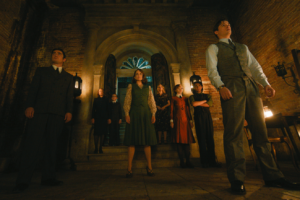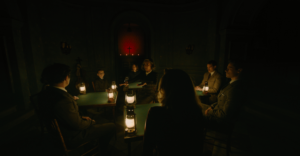Kenneth Branagh’s “A Haunting in Venice” marks his third swing directing and starring as Agatha Christie’s famed detective Hercule Poirot. And, perhaps due to the fact that her 1969 novel “Hallowe’en Party” has never been filmed before, this is the most satisfying. There’s no previous filmed adaptation to stand as comparison – as there was with 2017’s “Murder on the Orient Express” and 2022’s “Death on the Nile.”
This time, Branagh (via Christie) mixes the standard Poirot whodunit mystery with a page from the cinematic macabre, blending in ghosts, the supernatural, and even a good old-fashioned séance. That the two genres mix so well is a testament to Branagh and screenwriter Michael Green, who continually wet our proverbial whistle without ever reducing “A Haunting in Venice” to a full-blown horror flick. Poirot (Branagh) always keeps the stiff upper lip, as he discounts the metaphysical in favor of hard facts and observation.
Keeping one step ahead of Poirot (heck, just staying even with his brain) is always the fun of these exercises, and “A Haunting in Venice” provides plenty of opportunity for us to match wits with the great detective. In post-war Venice, a famed opera singer Rowena Drake (Kelly Reilly) organizes a séance in which a medium (Michelle Yeoh from “Everything Everywhere All at Once”) will attempt to contact the singer’s daughter, who died a year earlier in a tragic accident.
Also present for the proceedings are French actress Camille Cottin as Rowena’s housekeeper, Kyle Allen as her ex-fiance, Jamie Dornan as a doctor suffering from PTSD (or “Battle Fatigue” as they called it during and after WWII), Jude Hill as his creepy son, and a few others. Hill played the lead in Branagh’s autobiographical 2021 film “Belfast.” He isn’t given as much to do here, but this kid is an excellent young actor. In fact, the doctor and his son are two of the most interesting supporting characters, although (and perhaps because) we’re never really sure exactly what connection they have to the opera singer.
The problem is the inclusion of the character of Adriadne Oliver (Tina Fey), the author who writes the character of Poirot in this particular Christie novel. In other words, Oliver is the alter ego of Christie – a technique which probably works great in its original medium, but serves only to complicate matters in the conversion to film.
Much as with Kevin Kline’s private detective character in Robert Altman’s “A Prairie Home Companion” (a character reporting on the demise of the longtime radio show while at the same time serving as a character within the show), “A Haunting in Venice” would have been “cleaner” without the author character. Her only function is to invite Poirot to the séance – a gathering he otherwise would not attend. I realize this is the way Christie wrote the source material; but it doesn’t work for me within the confines of the film medium.
Consequently, the other characters are shortchanged from valuable screen time, and we’re left with stock characters who (for the most part) go undeveloped until Poirot unravels the mystery. As is the case with many of these Christie novels, there are usually one or two unnecessary characters who are more developed in novel form but seem extraneous when converted to a 90- to 120-minute film.
On the other hand, Haris Zambarloukos’ cinematography is excellent, as he employs many oft-used visual tricks of the past. Heck, there are enough Dutch angle shots here to stand alongside “The Third Man” or “Citizen Kane.” And while the flashbacks to the death of the young girl are shot in black-and-white, I can’t help but wonder if “A Haunting in Venice” might have been more effective had the entire film been shot in black-and-white. Not only would this technique match the time period setting of the film, but the cinematography harkens back to an earlier era of filmmaking.
“A Haunting in Venice” is by no means a perfect film, but it’s Branagh’s best Christie adaptation yet. Again, this is virgin cinema; this story has never been filmed before. And the melding of two cinematic genres, which would appear to be mutually incompatible on paper, works proficiently. With some rearranging of character emphasis, this one could have achieved greatness amid its familiarity.





